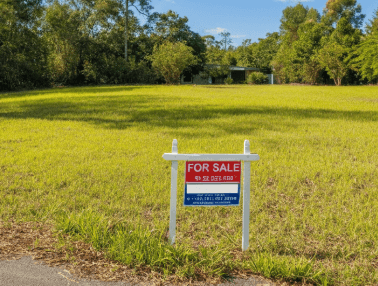Building your dream home starts with the crucial first step of purchasing land. In this blog, we’ll delve into and explore the essential tips for those looking to buy land and build a house. Understanding the complexities of land acquisition, zoning laws, and building regulations can make all the difference in creating a successful project. Whether you’re a first-time homebuyer or looking to upgrade your living situation, knowing how to buy land and build a house can empower you to make well-informed choices and avoid common pitfalls.
Steve Daria and Joleigh, seasoned real estate investors, offer invaluable insights into the land purchasing process. Their experience highlights the importance of conducting thorough research on local zoning laws and land use regulations to ensure your investment aligns with your building goals. By sharing their firsthand experiences, they aim to guide aspiring homeowners through the complex journey to buy and build a home.
Why Buy Land and Build a House?
When you buy land and build a house, it offers several advantages over purchasing an existing home.
Here’s why this approach might be the perfect fit for you:
Customization
Designing and building your own home allows for unparalleled personalization.
You can choose from the floor plan to the finishes, ensuring the house fits your specific needs and style.

Quality Control
By overseeing the construction process, you can ensure that high-quality materials and construction techniques are used.
This means fewer maintenance issues in the future and a home that meets your standards for durability and safety.
Investment Potential
Land often appreciates over time, which could increase the value of your property.
For example, if you buy land and build a house in a developing area, the value of your property could rise as the region grows and becomes more desirable.
Researching Locations and Evaluating Land
The first crucial step to buy land and build a house is choosing the right location and evaluating the land. Consider the following factors:
Choosing the Right Location
When selecting a location for your new home, think about proximity to work, schools, and amenities, as well as the overall vibe of the neighborhood.
For example, if you have children, you might prioritize areas with good schools and parks.
Investigating Zoning Laws and Regulations
When you buy land and build a house, zoning laws dictate what types of buildings and activities are permitted in certain areas. To ensure your plans are feasible:
- Check Local Zoning Maps: Review zoning maps to understand what is allowed on the land you’re interested in.
- Visit the Municipal Planning Office: Discuss your plans with local officials to get insights into any restrictions or special considerations.
- Understand Restrictions: Some areas may have restrictions on building height, design, or land use that could impact your plans.
Assessing Land Suitability and Features
Not all land is suitable for construction. Evaluate the following features to ensure your chosen plot meets your needs:
- Topography: Check if the land is flat or sloped. Sloped land may require additional excavation or retaining walls, affecting construction costs.
- Utilities: Ensure access to essential utilities like water, electricity, and sewage systems. If utilities are not available, you may need to budget for installation.
- Access: Verify that the land has convenient road access and is not landlocked.
Conducting a Soil Test
A soil test is crucial to determine if the ground is suitable for construction.
This test will reveal the soil’s load-bearing capacity and identify potential issues such as high moisture content or contamination.
For instance, clay-rich soil might require special foundations to prevent settling issues.
Get An Offer Today, Sell In A Matter Of Days
Budgeting and Financing Your Project
Understanding your financial situation is essential when you buy land and build a house.
Here’s how to budget and explore financing options:
Estimating Costs
Your budget should encompass all aspects of the project, including:
- Land Purchase: The cost of buying the plot.
- Construction: Includes building materials, labor, and permits. For example, high-end finishes will increase the overall cost.
- Utilities: Expenses for connecting essential services to your property.
- Unexpected Costs: Set aside a contingency fund for unforeseen issues like delays or changes in plans.
Exploring Financing Options
Several financing options are available for land purchase and construction:
- Construction Loans: These loans cover both the cost of the land and the construction. They typically have higher interest rates and are disbursed in stages based on construction progress.
- Land Loans: Used solely for purchasing the land. These loans may require a bigger down payment and have different terms compared to construction loans.
- Personal Savings: If you prefer to avoid debt, you can use personal savings. This option may avoid interest payments but requires having substantial funds available.
Working with Lenders
Choose lenders experienced in construction financing.
They can offer valuable advice and streamline the process.
For instance, a lender familiar with construction loans can guide you through the stages of disbursement and ensure you meet all necessary requirements.
Hiring Professionals to Help You Build
Building a house needs a group of skilled professionals. Here’s who you’ll need:
Finding a Real Estate Agent for Land Purchase
A skilled real estate agent can assist with:
- Negotiating Land Prices: They can help you get the best deal on your plot of land.
- Understanding Market Trends: Insights into local market conditions can guide your purchase decision.
- Handling Paperwork and Legalities: Ensuring all documents are correctly prepared and filed.
Selecting an Architect
An architect will bring your ideas to life. Choose someone who:
- Has a Portfolio of Similar Projects: Review their prior work to ensure their style aligns with your vision.
- Understands Your Needs and Style: Effective communication with your architect ensures they can design a home that meets your expectations.
- Offers Transparent Pricing and Timelines: Clear details on costs and project timelines help avoid surprises.
Choosing a Reputable Builder
Your builder will construct your home. Ensure they:
- Have Strong References and Reviews: Check their track record for quality and reliability.
- Are Licensed and Insured: Verify their credentials to ensure they meet industry standards.
- Provide Detailed Contracts and Warranties: Comprehensive contracts and warranties protect you from potential issues.
Designing Your Dream Home
This is where your vision begins to take shape.
Work closely with your architect and builder to finalize the design.
Planning the Layout
Consider how you will use each space daily. Think about:
- Flow: Ensure rooms connect logically and allow for smooth movement throughout the home.
- Functionality: Address practical aspects such as storage, lighting, and room proportions.
- Future Needs: Plan for potential expansions or modifications, such as additional bedrooms or office space.

Selecting Materials and Finishes
The materials you choose impact both aesthetics and durability. Decide on:
- Flooring: Options include hardwood, tile, or carpet. Select based on your lifestyle and design preferences.
- Countertops: Materials like granite, quartz, or marble offer different looks and durability.
- Exterior: Select from brick, siding, or stucco, considering both appearance and maintenance.
Incorporating Eco-Friendly Features
Sustainable features can reduce your environmental footprint and lower utility bills. Consider:
- Solar Panels: Install solar panels to harness renewable energy and reduce electricity costs.
- Insulation: High-quality insulation improves energy efficiency and reduces heating and cooling costs.
- Water-Saving Fixtures: Implement fixtures that conserve water, such as low-flow toilets and faucets.
Navigating the Construction Process
With your plans in hand, it’s time to start construction. Here’s what to expect:
Obtaining Necessary Permits
Before construction begins, secure all required permits, including:
- Building Permits: Authorization to start building your home.
- Environmental Permits: Necessary if your land impacts wetlands or wildlife habitats.
- Utility Permits: Required for connecting to water, electricity, and sewage systems.
Site Preparation
Site preparation involves:
- Clearing the Land: Remove debris and vegetation to prepare the site for construction.
- Grading: Level the land to ensure proper drainage and a stable foundation.
- Installing Temporary Utilities: Provide temporary services like electricity and water for construction purposes.
Managing the Build
Stay actively involved in the construction method by:
- Visiting the Site Regularly: Monitor progress and address any issues as they arise.
- Communicating with Your Builder and Architect: Keep open lines of communication to ensure your ideas are accurately realized.
- Addressing Issues Promptly: Resolve any problems or changes quickly to avoid delays.
Completing Your Home and Moving In
Once construction is complete, there are a few final steps before you can move into your new home:
Final Inspections
A series of inspections ensures everything is up to code. These may include:
- Building Inspection: Checks structural integrity and compliance with building codes.
- Electrical Inspection: Ensures safe and proper wiring.
- Plumbing Inspection: Verifies the functionality of water and sewage systems.
Receiving the Certificate of Occupancy
This document confirms that your home is safe and ready to be occupied.
It’s required before you can legally move in.
Decorating and Personalizing Your Space
Now comes the fun part—making your house feel like home. Consider:
- Furniture: Select pieces that complement your home’s design and enhance functionality.
- Decor: Add personal touches such as artwork, plants, and other decorative elements.
- Smart Home Features: Integrate modern technology for convenience, like smart thermostats and security systems.
Conclusion
Buying land and building a house is a significant and rewarding endeavor. By following these steps and tips, you can navigate the process effectively and create the home of your dreams. Begin by researching your ideal location, assembling a skilled team, and planning your project carefully. With the right preparation and support, you’ll be well on your way to buy land and build a house tailored to your distinct needs and preferences.
**NOTICE: Please note that the content presented in this post is intended solely for informational and educational purposes. It should not be construed as legal or financial advice or relied upon as a replacement for consultation with a qualified attorney or CPA. For specific guidance on legal or financial matters, readers are encouraged to seek professional assistance from an attorney, CPA, or other appropriate professional regarding the subject matter.

